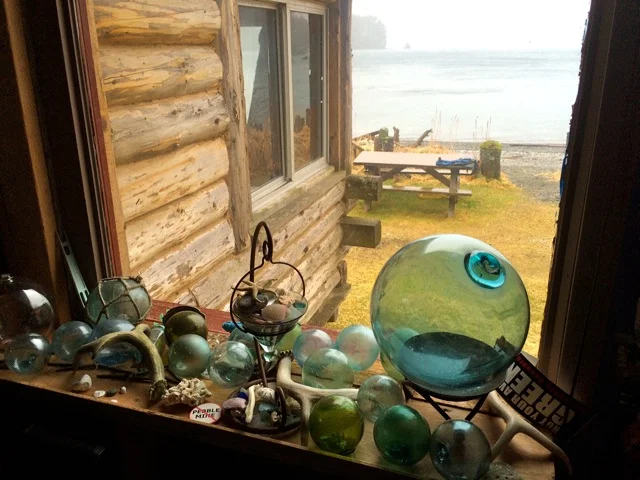President Obama was not the first American president to hold an Alaskan salmon on Alaskan soil when he visited last summer. Warren G. Harding was the first president to venture to the Last Frontier, back in 1923. Just as Obama was presented with a salmon at Dillingham, Harding was gifted salmon at Metlakatla. Obama prohibited off-shore oil and gas leasing in Bristol Bay during his visit, but his trip was more about curbing climate change than delving into fish policy. Conversely, while Harding is best remembered for driving the golden spike and completing the Alaska Railroad in Nenana during his jaunt, the deeper reason for his visit was to ascertain the nature of the supposed “Alaska Problem” and to determine the reception and implementation of his Executive Orders that created fishing reserves in Alaska.
President Harding eyes salmon in Metlakatla during his visit. Image courtesy NARA.
The so-called “Alaska Problem” was the stilted development of the territory. Following WWI, the population declined and industry stagnated. In 1919, Alaska’s salmon harvest fell by 1/3, from 6.6 million cases to 4.6 million (this was back when output was measured in cans, not pounds). Canners and fishermen clamored for the Bureau of Fisheries to do more to conserve the depleted salmon runs. Recall that prior to statehood, the federal government was responsible for the management of all Alaska fisheries, including salmon. Secretary of Commerce (and future president) Herbert Hoover accompanied the president on the trip, arranging public hearings in Juneau, Cordova, Seward, Nenana, Anchorage and Fairbanks to receive testimony on how the Bureau of Fisheries (part of the Department of Commerce) could improve its management of Alaska’s fisheries resources and to gauge the perception and implementation of fishing reserves in Alaska
The year before, in February of 1922, President Harding first created the Alaska Peninsula Fishery Reserve. Later that year, he created the Southwest Alaska Fishery Reserve, which encompassed both Bristol Bay and the Kodiak archipelago. These two reservations included 40% of Alaska’s primary salmon fishing areas. The reserves limited the number of canneries in any particular fishing area and the amount of gear and boats that could be utilized to harvest salmon. A finite number of fishing and processing permits were issued, rather than the free-for-all access that preceded the system. The permits specified the size of a cannery’s salmon pack. The expansion of fishing and canning operations was only permitted after the Bureau of Fisheries provided evidence that a given run had recovered or expanded.
The reception was mixed. Canners and the Bureau of Fisheries hailed this as a major step forward in management. For the canners, limiting the amount of fish that could be processed led to an enhanced pack value. For the Bureau of Fisheries, it advanced controlling fishing effort, a key strategy in improving conservation. However, Alaska’s territorial delegate to Congress, Dan Sutherland, lambasted the reserve system, asserting that it provided a monopoly to large canneries, that it limited access to a public resource, and that it gutted independent fishermen. Rationalization eliminates labor; unions were also very opposed to the fishing reserves. As an example, they cited what was transpiring at Karluk, where the two canneries licensed to operate in the area merely put in a weir to harvest salmon, slashing their need for fishermen. (They were subsequently reminded that it was illegal to place barricades in the river.)
Arriving in Seattle after his Alaska trip, President Harding spoke at the stadium at the University of Washington, addressing his time in the “empire of scenic wonders.” Harding insisted on maintaining the long view in regards to Alaska’s salmon, stating, “It is better to destroy the defiant investor than to demolish a national resource, which needs only guarding against greed to remain a permanent asset of incalculable value.” Yet we will never know how the president’s trip to Alaska might have impacted the territory or its fisheries, since he died shortly after giving this speech. In 1924, Congress crafted the White Act, which eliminated Harding’s reserves and disallowed controlling the amount of gear used in a fishery. The White Act became the primary means by which Alaska’s fisheries were managed until statehood was achieved in 1959.
Now, nearly 100 years later, as the state faces another Alaska Problem in terms of its fiscal stability, Harding’s comments continue to resonate:
“It is vastly more easy to declare for protection and conservation of such a resource, than to formulate a practical and equitable program. Fish hatcheries have been established to restock streams, but the results are still conjectural and controversial. Argument is advanced for the abolition of one method of fishing in one spot, the condemnation of another type in another, and so on, until there is a confusion of local controversies which no specific and exclusive prohibition will solve.”
Apparently he did learn something during his time in the north- simple solutions to Alaska’s problems are certainly elusive.
Note: This was initially published in Pacific Fishing.

